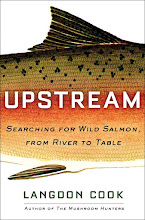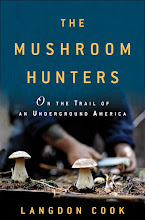This winter, mushroom hunters in California are crying
Hallelujah! Unless they happen to live below
Oroville Dam...
The Golden State hasn't seen rain like this in several years, and the fungi have responded in kind. But with so many storms rolling in off the Pacific, the mushroom patches have also taken a beating, so timing is still everything.
I was able to thread the needle earlier this winter, sneaking into Santa Cruz for a week of sunshine right after a major pummeling that washed out roads near where I was staying in the hills. The weather turned again just as I was leaving.
My destination was the
Santa Cruz Fungus Fair, one of the great myco events on the West Coast, but I also managed to get into nearby woods to pick a year-plus supply of candy caps.
I've written about candy caps before. It's a complex of species in the milk cap genus,
Lactarius. Candy caps are noteworthy for smelling intensely of maple syrup once dried, effectively putting mushrooms on the dessert menu. The two species of candy cap I encountered on this trip were
L. rubidus and
L. rufulus. The latter grows with oaks and is quite mild, but the former—if dehydrated at a low temperature (I think we set our dryer to 95 degrees)—is wonderfully fragrant. We found hundreds of them growing among a stand of old Monterrey pines.
Though
candy cap cookies are my usual go-to recipe, the first thing I made when I got home with my bounty was an
egg custard, adapting a very simple recipe that I typically make with huckleberries. The candy caps gave this creamy and satisfying dessert a pungent aroma of maple syrup, which paired well with the huckleberries on top.
1 small handful dried candy caps
1 cup evaporated milk
1 cup water
4 egg yolks
1/3 cup sugar
1/4 tsp salt
1/2 tsp vanilla extract
1/2 cup huckleberries
fresh nutmeg or cinnamon, grated to taste
1. Pulverize dried candy caps to dust in a spice grinder or food processor. Pass through wire mesh sieve to remove any large pieces. Cover mushroom dust with 1 cup warm water and set aside for 20 minutes.
2. Pre-heat over to 325 degrees. Combine milk and mushroom water in a small saucepan and bring to boil. Remove from heat.
3. Mix egg yolks, sugar, salt, and vanilla together in a bowl.
4. Slowly whisk in hot milk-water mixture until frothy. Pour into 4 ramekins.
5. Place ramekins in an oven-proof dish or tray filled with warm water. Bake for 40 minutes. Carefully place a small handful of huckleberries atop each custard and bake another 10 minutes. Test one for doneness with a knife tip; if it comes away clean, the custard is done. Sprinkle with fresh nutmeg or cinnamon. Serve hot or cold.










